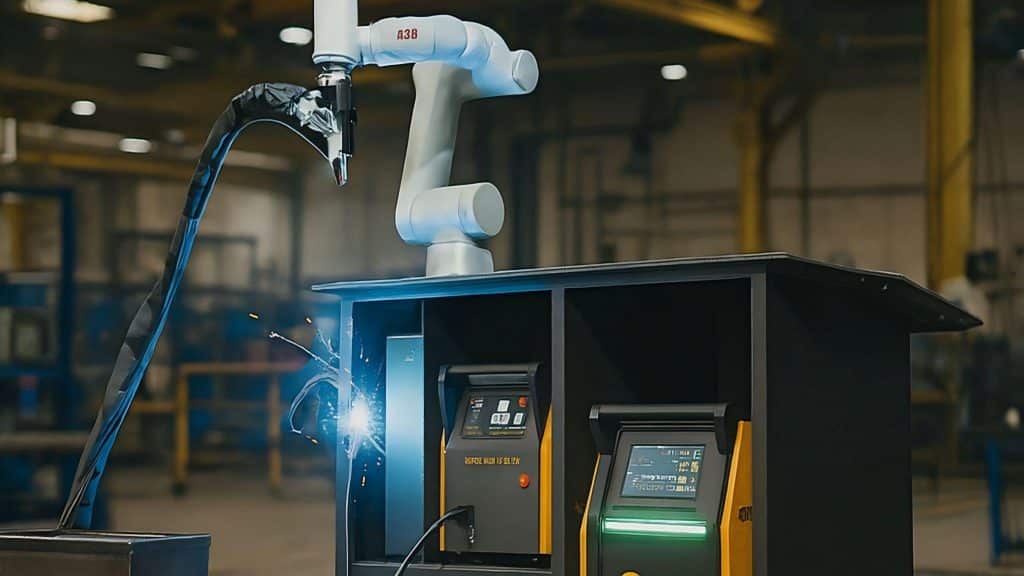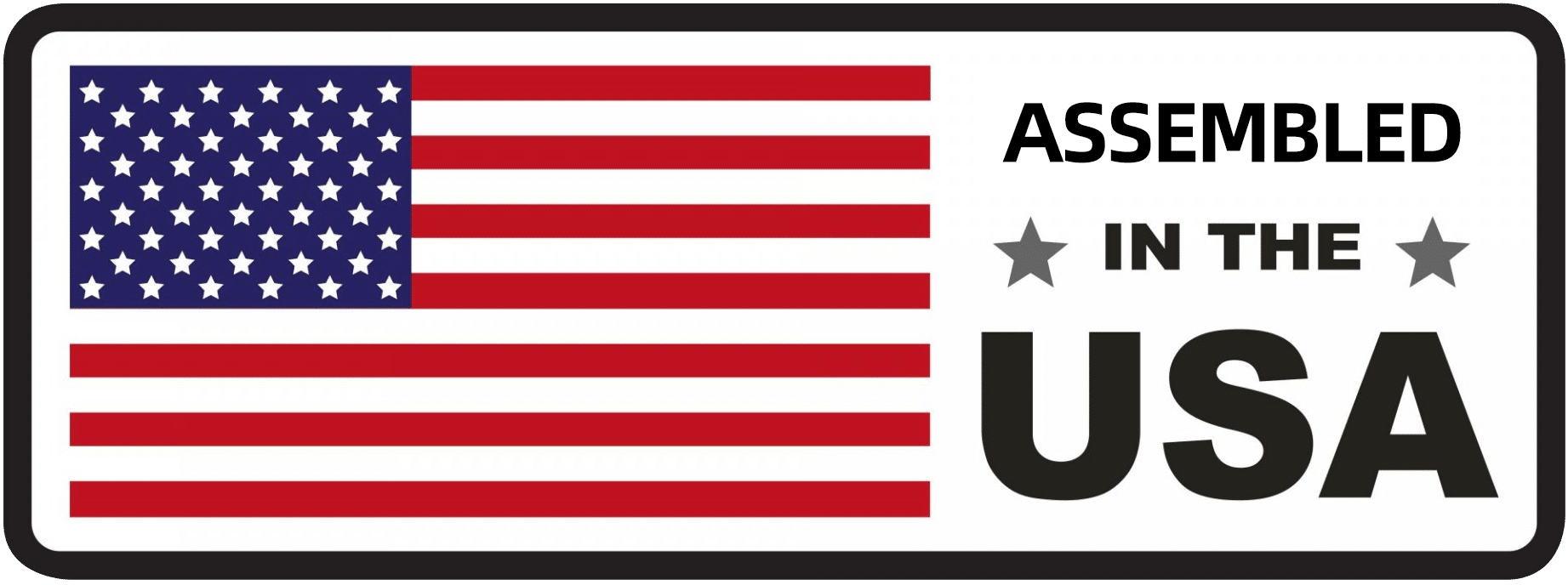
Some ongoing challenges hinder modern manufacturers’ productivity. For instance, workforce shortages, wrongly calibrated instruments, and limited scalability result in poor-quality and inefficient production.
Fortunately, the welding industry has evolved and incorporated modern technologies to transform workflows. One of the most prominent innovations is robotic laser welding, known for its high precision, reliable automation, and high-grade energy efficiency.
What Is Robotic Laser Welding and How Does It Work?
Robotic laser welding is a form of laser welding that uses a machine integrated with an industrial or collaborative robot (also known as “cobots”) to melt and fuse metals with minimal human intervention.
There are two common types of robotic laser welders.
- Fixed Robotic Arms: This technology utilizes large robotic systems programmed with advanced production algorithms to operate in automated assembly lines. This system can operate autonomously, but require safety enclosures because of their high speed and weight that can pose safety hazards to human workers nearby.
- Cobot-assisted Welding System: Smaller machines that are specifically designed to operate alongside human workers. Their design has built-in safety features, such as force-limiting technology that stops or slows down the system when detecting human presence to ensure everyone’s safety. Cobots are generally easier to program or often pre-programmed by the manufacturer.
An example of this is the Denaliweld’s Cobot Series, a compact and collaborative robotic solution for precision laser welding. This machine’s integrated cobot features an automatic welding head (Gofa 5/10/12) that supports real-time power adjustments throughout the welding process for enhanced precision and quality.
Benefits of Robotic Laser Welding in Modern Manufacturing
Robotic laser welding machines often require substantial capital to integrate in a production system. But this high initial cost is offset by the machines’ benefits to the overall productivity of the manufacturer.
Here are some benefits of using this type of technology.
- Improves Productivity: You can program the robotic laser welders in a way that they operate 24/7 at a consistent welding performance. This significantly reduces cycle times and fast-track your company’s product turnaround, especially in high-volume production lines.
- Higher Precision and Weld Consistency: The robotic arms are powered with automated motion and can be configured with optimal laser parameters to guarantee high-quality weld formation. The resulting weld is stronger, more robust, and with minimal heat-affected zones (HAZ).
- Minimal Post Processing: Laser welding is known for its ultra-precision that prevents any form of thermal distortion. Hence, all laser-welded joints are clean and spatter-free, which reduces the need for post-welding cleanups.
- Top Performance in High-mix, Low-Volume (HMLV) Production Setups: Laser robot paths and parameters (power, speed, pulse) are stored digitally for prompt utilisation. So, it is hassle-free to change from “Product A” to “Product B” in minutes, which prevents downtime between batches.
Top Use Cases Across Industries
The precision and efficiency of robotic laser welders make it an ideal solution to upgrade the product quality and reliability of various sectors such as:
Automotive Manufacturing
The modern automotive industry needs high-throughput and safe production systems. Robotic laser welding can fulfill the rapid and precise creation of seams across vehicle components. Robotic laser welders help in the production of body-in-white assembly, battery enclosures, exhaust systems, and transmission housings. The technique also allows the fusion of dissimilar materials, which are often used in automotive, such as advanced high-strength steels and aluminum.
Aerospace
Robotic laser welding can offer high-grade structural integrity and dimensional precision that are crucial in the production of heavy-duty and safety-compliant aircraft parts. This technology can join lightweight aircraft alloys, such as those made of titanium, magnesium, and aluminum, while preserving their metallurgical properties.
Moreover, the focused and high-energy beam can produce slender and high-fidelity welds with little to zero thermal deformation. Components such as fuselage frames, turbine assemblies, and hydraulic housings benefit from laser welding’s uniform penetration and minimal post-weld correction.
Shipbuilding
Modern ship construction entails large-scale structural elements and complex fluid systems. Robotic laser welding can deliver automated and uninterrupted welding operations for the timely and reliable production of high-integrity seams across extended joints in hull plates and internal bulkheads.
Electronics and Appliance Production
The electronics and home appliance industries can rely on robotic laser welding for a micro-scale method of assembling metallic enclosures, sensor housings, and conductive elements with minimal distortion of the surrounding materials. Common applications in this sector include the production of mobile device frames, lithium-ion battery shells, and compact circuit board cases.
Metal fabrication and Custom Manufacturing
Robotic laser welding is highly reliable in fusing workpieces with intricate geometries, wide-range of material composition, and various joint configurations. For this reason, this technology is widely applied in custom metal fabrication and manufacturing.
The Rise of Collaborative Robots (Cobots) in Welding
For small and medium-size manufacturers, it is recommended to utilize cobots in laser welding to automate and scale welding procedures for a variety of reasons such as:
Compared to traditional automation systems, cobots are intentionally designed to operate safely alongside human workers, which removes the need for isolated workspaces or costly protective barriers. This close interaction enables faster integration into existing workflows, which reduces downtime during implementation.
Programming a cobot demands less specialised knowledge, which allows companies to save on training costs and avoid dependence on external experts. Most cobot-integrated machines also feature pre-programmed algorithms which enables the operator to integrate the cobot laser welder into the production line immediately.
Most cobot laser welding equipment are lightweight with a smaller footprint that allows manufacturers to install them without the need to redesign production floors or expand workspaces.
Equipped with advanced sensors and motion control systems, cobots laser welder can adapt swiftly to subtle changes in position, material thickness, or joint configuration. Engineers can program exact parameters such as laser power, penetration speed, and focus point, to achieve uniform laser beam application across every weld.
Future Trends in Robotic Laser Welding
Robotic laser welding is today’s most sophisticated welding technique. But we are still in the early stages of this technology, so its near-future growth trajectory is promising.
Here are some of our forecasts about the future of this technology:
- AI Integration: Most machines will feature AI-powered quality monitoring and parameter optimization. This functionality can automatically assess project requirements and fine-tune relevant laser settings to achieve optimal weld quality.
- Real-time Sensor Feedback: Cobot laser welders will feature sensors that can detect welding conditions to allow the machine to automatically reconfigure its setting to adapt to dynamic welding requirements.
- Integration with Cloud Platforms and Industry 4.0 Standards: Future robotic laser welding systems might be capable of connecting with cloud platforms to enable real-time data exchange, remote diagnostics, and predictive maintenance across operators. Engineers will access performance metrics, error logs, and quality reports from anywhere to accelerate decision-making and reduce downtime.
Achieve Top-Quality and Consistent Welds With a High-Performing Robotic Laser Welding Machine
With its clear-cut beam precision, reliable automation algorithms, and consistent weld performance, robotic laser welding can give manufacturers the edge to stay ahead in the market. This technology’s capabilities extend to various industries and elevate their productivity and efficiency.
However, it requires a high-performing and reliable machine to experience the upsides of the robotic laser welding technology. Denaliweld, a global laser welding solution provider, offers advanced CE/SGS/WPQR-certified cobot laser welding machines that are quick to configure with zero manual recalibration. We also provide laser inventory machines, spare parts, 24/7 services, training and showrooms to our clients.



